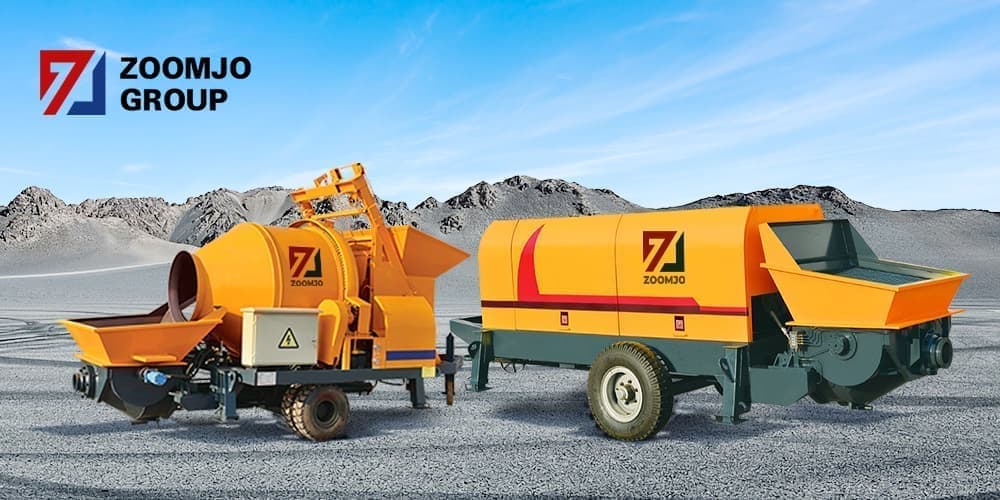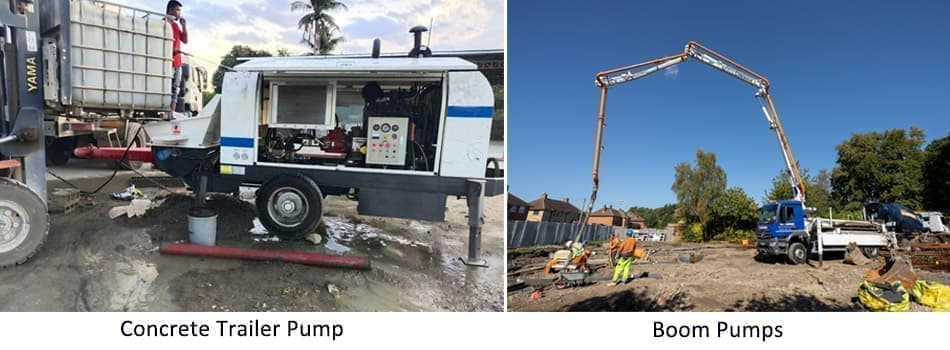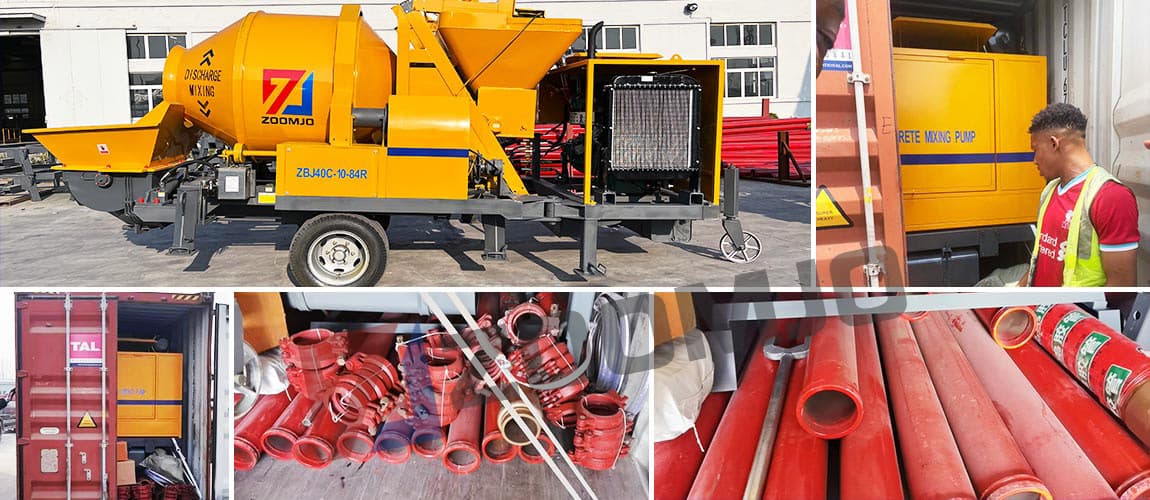How To Pump Concrete?

Concrete pumping is the use of pumps to continuously supply and pour liquid concrete in large quantities to specific locations that are inconvenient for other transportation methods. Pumping is a fast, reliable, efficient and economical way to place concrete neatly at specific job sites while minimizing concrete waste.
How to pump concrete?
Concrete pumps work using the basic principles of hydraulics and valve systems. At the job site, the mixer truck discharges the wet concrete into the hopper and the concrete pump uses a valve system to draw the liquid concrete into the hopper and push it to the area to be poured.
Most concrete pumps are equipped with dual hydraulic cylinders. The function of the first cylinder (feed cylinder) is to pull the concrete out of the hopper and the second cylinder (discharge cylinder) is to push the concrete out of the pump.
A skilled operator controls the operation, position and pump output of the concrete pump by controlling the unit's hose or boom. The operator is responsible for all tasks of the pump, such as transporting the pumping equipment to the job site, setting up the pump for the job, cleaning the pump after completing the job, and performing maintenance.

The most common types of concrete pumps
The two common types of concrete pumps are ground pumps and boom pumps. Both are suitable for different types of sites and are used for different purposes.
Ground (Line) pumps
Ground or line pumps are used to pump concrete via steel pipes or hoses along the ground to specific job sites that cannot be reached by trucks. The pump is usually mounted on a truck or trailer for easy towing and parking at a convenient location on the job site.
Some of the different types of concrete pipeline pumps include
Small/Micro Concrete Pumps - Ideal for small construction sites where space is tight because they are small and lightweight.
Portable Concrete Pumps - also known as mobile concrete pumps, mounted on a chassis with wheels for easy movement to various construction sites.
Concrete pump trailers - Concrete pumps mounted on single or multi-axle trailers. They are compact and use high pressure to pump concrete to longer distances.
Hydrostatic Concrete Pumps - Pumps that use pressure tanks to deliver concrete into pipes. They are suitable for sites that require large amounts of concrete, but do not require high pressure pumping.
Piston Concrete Pumps - Pumps that use a piston to push concrete out of a tank. They are suitable for sites that require high pressure and high flow rates.
Concrete Transfer Pumps - pumps that not only pump concrete, but also transport concrete to where it is needed, making them suitable for job sites where concrete needs to be transported to hard-to-reach places.
Boom Pumps
A boom pump is a piece of equipment used to convey concrete vertically, often in areas that cannot be reached by line pumps, such as roofs and high-rise buildings. A boom pump consists of a long, automated mechanical arm and hopper that can be extended and moved to the desired location by operator control, allowing for efficient work and smooth traffic flow.
The boom pump is usually mounted on a truck or semi-trailer and remains in one place for the entire pouring process. The ready-mix truck discharges the liquid concrete into the pump's hopper, where the hopper mixes the concrete and keeps it in a liquid state.
Concrete boom pumps are usually divided into two types: by host power engine type, including electric concrete boom pumps and diesel concrete boom pumps; by boom length, including short boom type (boom length 13-28m), long boom type (boom length 31-47m) and extra long boom type (boom length 51-62m).
The price of a concrete pump depends mainly on the type, model and configuration of the concrete pump. Specifically, the cost of a concrete pump ranges from $15,000 to $48,000. The table below shows the configurations of diesel and electric concrete pumps and their prices.

How Pumped Concrete Works
The process of pumping concrete is accomplished by using a sequence valve to disperse the hydraulic oil from the main pump into the main cylinder, pushing the piston rod of the main cylinder forward and backward, which causes the piston of the concrete cylinder to move as a whole, drawing the concrete in or pushing the concrete out of the concrete cylinder. At the same time, the high pressure oil pushes the swing arm driven by the swing cylinder, which drives the S pipe to switch back and forth between the outlets of the two concrete cylinders alternately. During the whole pumping process, the continuous reciprocating movement of the concrete cylinder and the back and forth switching of the S pipe realize the continuous concrete suction and discharge pressure.
Benefits of concrete pump
Concrete pump has the following advantages over the traditional method of distributing concrete by lifting concrete with buckets and cranes:
1. Higher volume of concrete poured per hour: While cranes have a lifting capacity of approximately 12 cubic meters per hour, concrete pumps can pump to high-rise buildings at a much faster rate of over 50 cubic meters per hour.
2. Faster pouring speed: concrete pumps are a faster and easier way to pour concrete. A hose or pipe connected to the outlet of the pumping equipment easily reaches all areas of the job site.
3. Reduced labor: The labor shortage in the construction industry makes it challenging to find skilled labor for the job. This can be remedied by using concrete pumps, where the entire concrete placement process can be completed by several operators with minimal labor.
4. Higher Concrete Pouring Accuracy: No matter what pump you choose, you can achieve higher concrete pouring accuracy and quality. It also reduces material waste and allows concrete to be poured on high-rise buildings and even foundation slabs without leaving spills and lumps.
5. Improved concrete strength: Since concrete pumps require less water, they prevent concrete from shrinking and cracking after installation. Therefore, a strong, quality concrete structure requires minimal maintenance and repair.

Some factors affecting pipe pressure:
Factors that affect pipeline pressure include pipe diameter, line length, horizontal and vertical distances, line bends and section reductions. Large diameter pipelines require less pumping pressure but have the disadvantages of high clogging, support and labor costs. Longer pipelines increase friction, and steel pipes with smooth walls can reduce resistance. The layout of the pipeline should minimize bending. The use of longer reducers reduces resistance and requires less force to push concrete through a long reducer compared to a shorter one.
ZOOMJO is a company specializing in the production and sale of concrete pumping equipment, with a wealth of experience and expertise in the industry. With ZOOMJO, you can get more detailed information about concrete pump equipment and get professional advice to make sure you choose the right equipment for your needs and budget.

 English
English  Español
Español  简体中文
简体中文  Pусский
Pусский  українська
українська 
